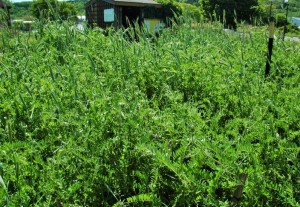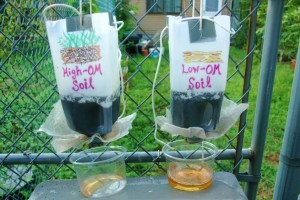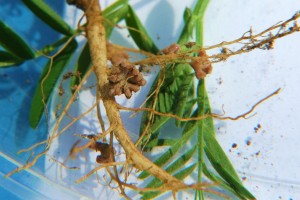Megan M. Gregory, Blog Contributor, Cover Crop Nerd, and Graduate Research Assistant, Cornell University
Email: meganmgregory1@gmail.com
Website: http://blogs.cornell.edu/gep/
This article is part of a four-part series about cover cropping in vegetable gardens. Stay tuned next week for Part II
- Part II: Types of Cover Crops — Non-Legumes, Legumes, and Mixtures (oh, my!)
- Part III: Selecting Cover Crops for Vegetable Gardens
- Part IV: Planting and Managing Cover Crops in Vegetable Gardens
What are cover crops, anyway?

Cover crops are close-growing plants sown in rotation with food crops, or inter-seeded between food crops to cover bare ground. They are not harvested, but rather are planted to improve soil quality and provide other benefits for crop production and the environment. Before planting the next vegetable crop, most cover crops need to be cut down. The shoots can be chopped (or mowed) and left as mulch on the soil surface, or incorporated into the soil.
There is a large body of research supporting the use of cover crops on organic and sustainable farms.1 However, vegetable gardeners can successfully plant and manage cover crops with hand tools, and reap the benefits of this practice for their soil and crops.2
Why should I plant a crop that I’m not going to harvest?
Cover crops provide many benefits for future vegetable crop production, and for the garden agro-ecosystem as a whole. Incorporating cover crops in vegetable rotations may:
- Increase soil organic matter levels, and therefore improve soil quality. As cover crop roots and shoots decompose, they build soil organic matter. This improves soil structure and water-holding capacity (Fig. 2), and increases slow-release nutrient reserves.3 Fresh cover crop residues also nourish beneficial soil fauna (bacteria, fungi, worms, etc.) that improve soil tilth and aeration, recycle plant and animal wastes, and release nutrients for crops to use.
- Provide nitrogen for future food crops through legume nitrogen fixation. Cover crops in the legume family (e.g., beans, peas, clovers, and vetches) add “new” nitrogen (N) to the soil. Legumes host N-fixing bacteria in bumps on their roots, also called nodules (Fig. 3). These bacteria take N from the air and convert it to a form the legume can use . When the plant decomposes, the fixed N also becomes part of the soil organic matter. Eventually, this N is released by microbes for crop uptake.4
- Improve nutrient retention and recycling. Over-wintering cover crops take up extra nutrients at the end of the growing season, which would otherwise be lost to leaching (when nutrients dissolve in rainwater and drain below the root zone, making the nutrients unavailable for plants). Over-wintering grasses like rye reduce N leaching by about 70% compared to bare soil.5
- Suppress weeds. Growing cover crops reduce weed growth through competition (e.g., for space, light, moisture, and nutrients) and allelopathy (releasing chemicals that inhibit other plants). After , the cover crop mulch can prevent weed seedling emergence through the growing season.6
- Attract beneficial insects. Cover crops often provide important resources (such as nectar and pollen and over-wintering habitat) for beneficial insects, including pollinator bees and natural enemies of insect pests like ladybugs and lacewing.1
- Increase or maintain crop yields with less inputs. Well-managed cover crops can improve vegetable crop yields, or reduce the amount of fertilizer needed to obtain good yields.7-10

- On the left is soil from an urban garden that received a rye/vetch cover crop for more than five years, and therefore has high SOM.
- On the right is soil from a garden that never received cover crops, and has lower SOM.
- This photo was taken 30 minutes after pouring equal amounts of water through the soils. The high-OM soil held most of the water, while much water drained through the low-OM soil. Since both soils were of similar texture, the difference in water-holding capacity can be attributed to the SOM.

* * * * * * * * * * * * *
Vegetable gardeners have a number of cover crop options suited to different seasonal niches, management goals, and environmental conditions. To learn about the main groups of cover crops and how to select cover crops for your garden, see Part II (Types of Cover Crops) and Part III (Selecting Cover Crops).
References
(1) Clark, A. 2007. Managing cover crops profitably, 3rd ed. Sustainable Agriculture Network, Beltsville, MD. Accessed online at: http://www.sare.org/Learning-Center/Books/Managing-Cover-Crops-Profitably-3rd-Edition, 7 December 2014.
(2) Gregory, M. M. and L. E. Drinkwater. In preparation. Developing cover cropping practices to improve soil quality, nutrient cycling, and weed suppression in urban community gardens.
(3) Snapp, S. S., S. M. Swinton, R. Labarta, D. Mutch, J. R. Black, R. Leep, J. Nyiraneza, and K. O’Neil. 2005. Evaluating cover crops for benefits, costs and performance within cropping system niches. Agronomy Journal 97(1):322-332.
(4) Drinkwater, L. E. 2011. It’s elemental: How legumes bridge the nitrogen gap. The Natural Farmer, Summer 2011, pp. B-1 – B-6. Northeast Organic Farming Association, Barre, MA. Accessed online at: http://www.nofa.org/tnf/Summer2011B.pdf, 6 December 2014.
(5) Tonitto, C., M. B. David, and L. E. Drinkwater. 2006. Replacing bare fallows with cover crops in fertilizer-intensive cropping systems: A meta-analysis of crop yield and N dynamics. Agriculture Ecosystems & Environment 112(1):58-72.
(6) Schonbeck, M. 2011. How cover crops suppress weeds. Accessed online at: https://www.extension.org/pages/18524/how-cover-crops-suppress-weeds, 6 December 2014.
(7) Abdul-Baki, A. A., J. R. Teasdale, R. Korcak, D. J. Chitwood, and R. N. Huettel. 1996. Fresh-market tomato production in a low-input alternative system using cover-crop mulch. HortScience 31(1):65-69.
(8) Abdul-Baki, A. A., J. R. Stommel, A. E. Watada, J. R. Teasdale, and R. D. Morse. 1996. Hairy vetch mulch favorably impacts yield of processing tomatoes. HortScience 31(3):338-340.
(9) Abdul-Baki, A. A., J. R. Teasdale, R. W. Goth, and K. G. Haynes. 2002. Marketable yields of fresh-market tomatoes grown in plastic and hairy vetch mulches. HortScience 37(6):878-881.
(10) Abdul-Baki, A. A., J. R. Teasdale. 1997. Snap bean production in conventional tillage and in no-till hairy vetch mulch. HortScience 32(7):1191-1193.

Another benefit is that a winter cover crop helps maintain year around live roots for colonization by arbuscular mycorrhizal fungi. Although roots of members of the Brassica genus do not form a symbiotic relationship with mycorrhizal fungi, the roots of most vegetable crops do form a symbiotic association with arbuscular mycorrhizal fungi and the gardener can take advantage of this. In annual vegetable gardens, the soil is fallow for at least half of the year and the arbuscular mycorrhizal fungi quickly disappear without a food source. A winter cover crop provides live roots to help over winter a good mycorrhizal fungi population to infect the roots of vegetables the following spring.
Given the large amount of research in the last 30 years that has demonstrated the advantages of mycorrhizal fungi, I believe the time has come to promote the benefits of mycorrhizas to the home gardener. Winter covers crops would encourage more arbuscular mycorrhizal fungi. Another benefit is that increased mycorrhizas would lead to greater production of glomalin. As well, fresh plant residues incorporated into the soil each spring would result in greater production of extracellular polysaccharides by soil bacteria. Glomalin and extracellular polysaccharides are the two most important microbial glues for increasing soil particle aggregation and hence improved soil structure.
Thank you for mentioning yet another benefit of cover crops – providing a host for mycorrhizae at times when the soil would otherwise be fallow in vegetable gardens. Studies have compared how well arbuscular-mycorrhizal fungi (AMF) colonize the roots of food crops after bare fallow vs. winter cover crops. After certain winter cover crops, food crops have shown greater AMF colonization, nutrient uptake, and yields (Gosling et al., 2006 and references therein). Of course, we still have a LOT to learn about how gardeners can most effectively promote healthy AMF populations in their soils, but here are a few suggestions:
1. Grow mycorrhizal cover crops during ‘gaps’ in your vegetable rotation to provide constant hosts for beneficial AMF. Mycorrhizal cover crops include clovers, vetches, and cereals such as oats and wheat, among others. If you want to grow a non-mycorrhizal cover crop (like a Brassica or buckwheat), plant it in a mixture with a mycorrhizal cover crop.
2. Minimize tillage. This can damage the network of hyphae (long filaments that make the body of a fungus), and reduce AMF colonization of subsequent crops. When you plant cover crops, try to use the ‘cut-and-mulch’ method rather than incorporating them into the soil. This involves waiting for the cover crops to flower, then cutting them off at the base and leaving chopped shoots as mulch. Then, you can push apart the mulch and dig holes just where you want to set your vegetable transplants, leaving the rest of the soil (and the network of fungal hyphae!) undisturbed and ready to colonize your vegetable seedling’s roots.
3. Minimize (or eliminate) the use of inorganic (chemical) fertilizers. These have been shown to harm AMF in some cases. Organic fertilizers, such as composts and manures, usually do not harm AMF and may even stimulate them – but be careful not to over-apply phosphorous, as often happens when gardeners rely heavily on animal-manure-based composts.
Reference:
Gosling, P., A. Hodge, G. Goodlass, and G.D. Bending. 2006. Arbuscular mycorrhizal fungi and organic farming. Agriculture, Ecosystems, & Environment 113:17–35
This is kind of a cover crop question, I suppose. When I clean up my bean beds each fall I pull up the entire plant, especially if I’m going to thresh off dried beans later. Should I be cutting them and leaving the roots in the soil instead?
Hi Mark – Good question! I would lean away from leaving residue from a food crop (as opposed to a cover crop) in the soil. The main reason to remove food crop residues is to break disease cycles (although this would be less important if you plan to rotate into crops in different families for the next 2-3 years). Also, most of the nitrogen fixed by legume food crops (like beans) will go into the harvested pods, so you wouldn’t return very much to the soil anyway.
When growing a cover crop, it’s a different story (stay tuned for Part IV of this series for more info!). Briefly, I DEFINITELY encourage people to cut off the plants at the base (once they flower – otherwise they will regrow!) and allow the roots to rot “in place” in the soil. The chopped shoots can be left as mulch on the soil surface. Leaving the roots to decompose in the soil has many benefits for building organic matter levels and improving soil structure and aeration. Since you are ideally planting cover crops in a different family from the food crop you plan to plant next, this shouldn’t pose a problem for soil-borne diseases. And since cover crops are sown much closer together than food crops and are killed before they go to seed, you’ll add much more organic matter and (for legumes) fixed nitrogen to the soil than you would with just the roots of a bean crop.
Cover cropping is something new to me. Do you thing that the cover crop will take out nutrients and other good stuff from what you’re harvesting ? Or does the good far out way the bad? Thanks for all the great info.
Hi Matt – Thanks for your interest!
Cover crops are usually planted IN BETWEEN food cropping cycles (when the soil would otherwise be bare) so they don’t compete directly with your food crops. For example, summer cover crops like buckwheat fit nicely in the late June – mid-August window between early spring crops (like lettuce) and transplanted crops for a fall harvest (like broccoli). Over-wintering cover crops are planted in September and October — near the end of the growing season — to protect the soil over the winter. For more information on designing vegetable rotations with cover crops, stay tuned for Part III of this series. You can also check out some handouts I made on garden planning (for USDA Zone 6 at: http://blogs.cornell.edu/gep/files/2013/08/Garden-Planning-Ithaca-1aow3xc.pdf, and Zone 7 at: http://blogs.cornell.edu/gep/files/2012/09/Garden-Planning-Handout-1bb9z1l.pdf).
Often gardeners may wish to ‘under-seed’ over-wintering cover crops beneath and between food crops finishing up for the season, so the cover crops can get established before the winter. In this case, the food crops have such a big ‘head start’ that competition from cover crop seedlings is not a problem.
One situation where cover crops may have a negative effect on the next food crop is when gardeners incorporate a pure stand of a non-legume (say, winter rye) and fail to wait a few weeks before planting veggies. This can result in temporary ‘nitrogen tie-up’ as microbes take up soil nitrogen to balance all the carbon in the rye residues they’re breaking down (see this article, “Drawbacks of non-legumes.”) To mitigate this problem, I suggest planting grass-legume mixtures, since the high nitrogen content of the legume will balance out the high carbon content of the non-legume.
There has been some research on ‘inter-seeding’ cover crops with growing food crops, often for weed control between rows of vegetables on farms. When water is sufficient, legumes like hairy vetch can be planted between rows of vegetables 20-30 days after transplanting without harming yield. Grasses like oats are probably too competitive even when planted 30 days after transplanting (Brainard et al., 2004).
Bottom line: When cover crops are planted in a different seasonal niche than food crops, or when legumes are interseeded at least a month after transplanting food crops, competition should not be a problem. Most cover crops will actually increase the amount of nutrients available to the next crop. Legumes can add nitrogen to the system through nitrogen fixation, and Non-legumes (like rye) take up nutrients in the soil at the end of the growing season, which might otherwise be lost to leaching (this happens when nutrients in the soil dissolve in water, and the water drains below the root zone). Then, when the cover crop residues are returned to the soil, the nutrients are released for future food crops as the cover crops decompose.
Hope this helps answer your question!
Reference:
Brainard, D.C., R.R. Bellinder and A.J. Miller. 2004. Cultivation and interseeding for weed control in transplanted cabbage. Weed Technology 18:704-710.
We regularly cover crop part of our vegetable garden even in production season (this year we cover croped all 1000 sq. feet of it as we had other projects preventing tending to it). I have a question though. We have a very large, old Balsam Poplar north of the veggie garden. It’s allellopathic to some plant species by killing Frankia Rhizobium bacteria. We kind of learned to live with it and supplement Nitrogen for certain crops, and not planting others. Every year we ask ourselves if we should just get rid of the tree and replace it with a different one. Every year we decided against it. We and our neighbours, after properly ranting against its sticky fruits in spring, appreciate the large area of dappled shade it provides in summer. But now, reading this article and the comments, I wonder if the Balsam poplar doesn’t kill or seriously impede other mycorrhizal fungi our cover-croping efforts might produce. Any thoughts/ideas? Thanks.
There is no evidence, for any species, of allelopathic activity in the field. What happens in the lab, or in pot experiments, does not necessarily apply to the more complex outdoor conditions particularly in home gardens and landscapes. This fact sheet on juglone discusses the topic, as black walnuts have been studied exhaustively for allelopathy. http://cru.cahe.wsu.edu/CEPublications/FS325E/FS325E.pdf